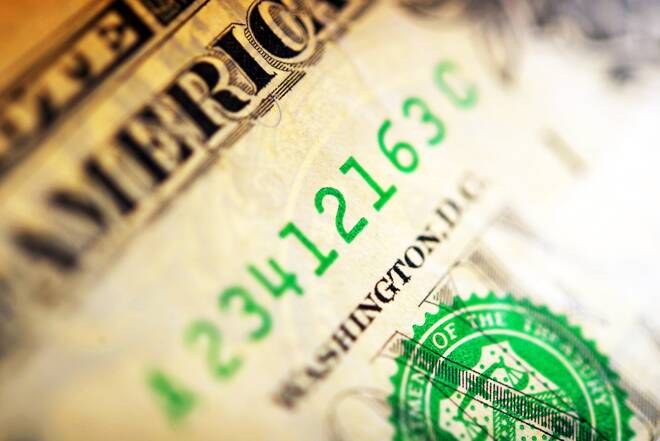Advertisement
Advertisement
The Weekly Wrap – Fed Chair Powell Delivered Friday Comfort
By:
A volatile week for the global financial markets ended with Fed Chair Powell assuring the markets of no larger rate hikes, which eased market tensions.
The Stats
It was a quiet week on the economic calendar for the week ending May 13, 2022.
A total of 45 stats were monitored, following 62 stats in the week prior.
Of the 45 stats, 20 beat forecasts, with 22 economic indicators falling short of forecast. Three stats were in line with forecasts.
Looking at the numbers, 13 of the stats reflected an upward trend. Of the remaining 32 stats, 30 stats were weaker.
Out of the US
Inflation was back in focus, which caused market turbulence mid-week.
In April, the annual rate of inflation softened from 8.5% to 8.3% versus a forecasted 8.1%. The core annual rate of inflation softened from 6.5% to 6.2%. While softer, inflation was stronger than anticipated, supporting the more hawkish sentiment towards Fed monetary policy.
On Thursday, wholesale inflation also drew attention. In the month of April, the core producer price index increased by 0.4% after a 1.2% rise in March.
Initial jobless claims had a muted impact despite a rise from 202k to 203k in the week ending May-06.
On the monetary policy front, Fed Chair Powell calmed the markets on Friday, assuring that larger rate hikes remained off the table.
In the week ending May 13, 2022, the Dollar Spot Index rose by 0.87% to end the week at 104.563. In the week prior, the Index rose by 0.68% to 103.660.
Out of the UK
GDP and production figures were the main areas of focus in the week.
The stats were Pound negative, with the UK economy contracting in March and production hitting reverse.
In the first quarter, the UK economy grew by 0.8% quarter-on-quarter versus a forecasted 1.00%. The economy expanded by 1.3% in the previous quarter.
Year-on-year, the economy grew by 8.7% versus a forecasted 9.0%. The economy expanded by 6.6% in the fourth quarter of last year. More significantly, the economy contracted by 0.1% in March, after no growth in February.
Production figures also provided little comfort.
Production fell by 0.2%, partially offset by construction (+1.7%), with manufacturing production declining by 0.2%.
In the week, the Pound fell by 0.70% to end the week at $1.2262. The Pound tumbled by 1.79% to $1.2348 in the week prior.
The FTSE100 ended the week up 0.41%, partially reversing a 2.08% loss from the previous week.
Out of the Eurozone
ZEW Economic Sentiment figures for Germany and the Eurozone and Eurozone industrial production figures were the key stats.
In May, economic sentiment improved, with Germany’s ZEW Economic Sentiment Index up from -41.0 to -34.3. The Eurozone’s ZEW Economic Sentiment Index climbed from -43.0 to -29.5.
At the end of the week, industrial production disappointed, however.
In March, industrial production fell by 1.8% to test EUR support. Production rose by a modest 0.5% in February.
For the week, the EUR slid by 1.32% to $1.0412. In the previous week, the EUR rose by 0.06% to $1.0551.
The DAX rallied by 2.59%, with the EuroStoxx600 and the CAC40 seeing gains of 0.83% and 1.67%, respectively.
For the Loonie
It was a quiet week on the economic data front, leaving the Loonie in the hands of market risk sentiment.
In the week ending May 13, the Loonie fell by 0.42 to C$1.2929 against the greenback. The Loonie slipped by 0.21% to C$1.2875 in the week prior.
Elsewhere
It was a bearish week for the Aussie Dollar and the Kiwi Dollar.
The Aussie Dollar slid by 1.92% to $0.6940, with the Kiwi Dollar tumbling by 2.09% to end the week at $0.6276.
For the Aussie Dollar
Business and consumer confidence numbers disappointed.
In April, the NAB Business Confidence Index fell from 16 to 10. The Westpac Consumer Sentiment Index fell by 5.6% in May, following a 0.90% decline in April.
For the Kiwi Dollar
Electronic card retail sales reversed a 1.3% decline with a 7.0% jump in April. The Business PMI disappointed, however, falling from 53.8 to 51.2.
For the Japanese Yen
Service sector PMI and household spending drew market interest in a quiet week on the data front.
In April, Japan’s services PMI rose from 49.4 to 50.7, up from a prelim 50.5. Service sector activity picked up in response to the government removing remaining COVID-19 restrictions.
Household spending figures disappointed, however. In March, spending slid by 4.1%, following a 2.8% decline in February.
The Japanese Yen rose by 1.03% to end the week at ¥129.22 against the dollar. In the week prior, the Yen ended the week down by 0.66% to ¥130.56.
Out of China
Trade and inflation tested investor appetite for riskier assets.
In April, exports increased by 3.9%, year-on-year, versus a forecasted 3.2% rise. Exports were up 14.7% in March.
The US dollar trade surplus widened from $47.38bn to $51.12bn as imports stalled.
Inflationary pressures picked up in April, with the annual rate of inflation accelerating from 1.5% to 2.1%.
In the week ending May 13, the Chinese Yuan slid by 1.84% to CNY6.7893. The Yuan declined by 0.88% to CNY6.6667 in the week prior.
The Hang Seng Index ended the week down 0.52%, while the CSI300 rose by 2.04%.
About the Author
Bob Masonauthor
With over 28 years of experience in the financial industry, Bob has worked with various global rating agencies and multinational banks. Currently he is covering currencies, commodities, alternative asset classes and global equities, focusing mostly on European and Asian markets.
Advertisement
